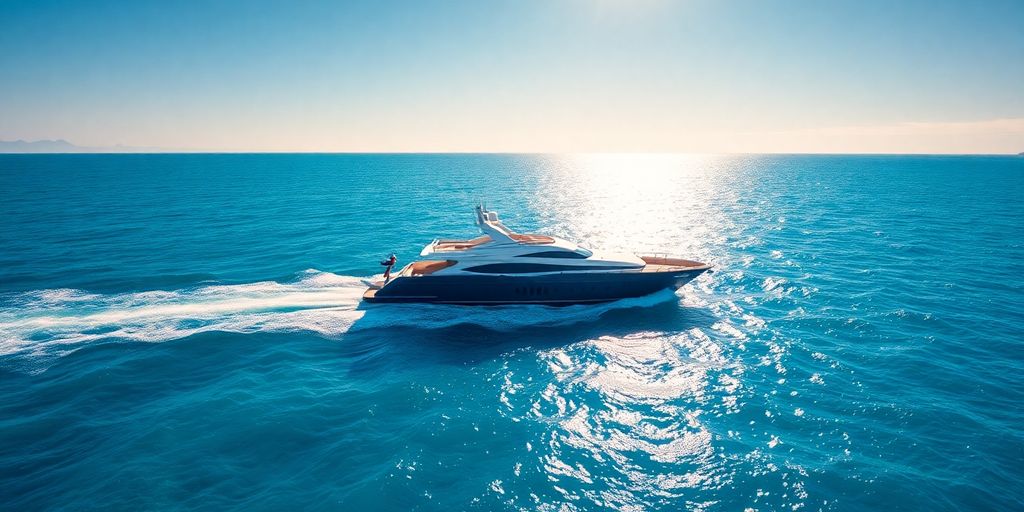So, you’re thinking about chartering a yacht and wondering about the timing. It’s a fair question: how long is a charter season? It’s not quite as simple as just picking a month. The length of a yacht charter season really depends on where you want to go and what kind of weather you’re looking for. Let’s break down what influences these seasons and when the best times to book might be.
Key Takeaways
- A yacht charter season isn’t a fixed global period; it changes based on location, weather, and local events.
- Summer seasons, like in the Mediterranean, typically run from May to September, with July and August being the busiest months.
- Winter seasons, often found in the Caribbean, usually span from late October to March, with holidays being the peak time.
- Shoulder seasons, falling between peak and off-peak times, offer a good balance of decent weather and fewer crowds.
- Booking well in advance, especially for peak times, is important, and a yacht broker can help you find the best options.
Understanding Yacht Charter Season Length
When you’re thinking about booking a yacht charter, one of the first things that probably pops into your head is, ‘When should I go?’ It’s not quite as simple as picking a date on a calendar, because yacht charter seasons aren’t the same everywhere. They really depend on where you want to sail and what kind of weather you’re hoping for. Think of it like planning a ski trip – you wouldn’t go in July, right? Yachting has its own rhythm, and understanding that is key to a great trip.
Defining A Yacht Charter Season
A yacht charter season is basically the period of the year when cruising conditions are considered best for a particular destination. This usually means the weather is pleasant, the seas are calm, and most of the local attractions and services are open and ready for visitors. It’s the time when most people want to be out on the water in that specific region. These seasons are generally dictated by the local climate and water conditions.
Factors Influencing Season Duration
Several things can affect how long a charter season lasts. The most obvious is the weather – areas prone to hurricanes or monsoon seasons will naturally have shorter, more carefully planned seasons. Local events and festivals can also play a big role, drawing crowds and increasing demand. Sometimes, the availability of specific yachts, or even the owner’s personal use schedule, can limit when a yacht is actually available for charter. It’s a mix of natural patterns and practical considerations.
Global Variation In Charter Seasons
It’s really important to remember that there’s no one-size-fits-all answer to how long a charter season is. Each part of the world has its own unique schedule. For instance, the Mediterranean is a prime summer spot, with its season running from roughly April to October. On the flip side, places like the Caribbean really shine in the winter. This global difference means you have options year-round, but you need to know where to look for what you want. A good yacht broker can really help you figure out the best time and place for your trip, using their knowledge of Mediterranean yacht charter schedules and other popular spots.
The timing of your charter can significantly impact your experience, from the weather you encounter to the crowds you’ll be sailing with and the prices you’ll pay. Planning around these seasonal shifts is part of the adventure.
Summer Charter Season Insights
The summer months are prime time for yacht charters, especially in popular cruising grounds like the Mediterranean and New England. This period generally offers the most pleasant weather, making it ideal for exploring coastlines, enjoying water sports, and experiencing vibrant local culture. However, it’s also the busiest time, so planning ahead is key.
Mediterranean Summer Charter Period
The Mediterranean yacht charter season typically kicks off around mid-May and extends through mid-September. This region is a global hotspot for summer charters, drawing visitors with its warm, sunny climate and a packed calendar of events. Think of the glitz of the Cannes Film Festival, the lively club scene in Ibiza, or the delicious food festivals along Italy’s Amalfi Coast. These events add an extra layer of excitement to an already appealing charter experience. Greece, for instance, boasts a slightly longer season, running from April to October, offering more flexibility for those wanting to soak in its beauty. Similarly, Spain’s Balearic Islands, including Ibiza and Mallorca, are legendary summer destinations known for their beaches and nightlife.
Peak Summer Charter Months
Within the broader summer season, the absolute peak months for chartering in the Mediterranean are July and August. During this two-month window, demand is at its highest, which often means charter rates can increase by about 10%. Many yachts get booked up well in advance, so if you’re aiming for this period, securing your booking early is highly recommended. The 2025 yacht charter season is already seeing an increase in advanced bookings, highlighting this trend. For New England, the peak is a bit tighter, usually from mid-July to mid-August, with the overall season running from mid-June through August.
New England Summer Charter Timing
Across the pond, New England offers a distinct summer charter experience. The season here generally runs from mid-June through August. It’s a fantastic alternative for those seeking a different kind of summer escape, with charming coastal villages, historic lighthouses, and beautiful national parks. The peak period for New England charters typically falls between mid-July and mid-August, mirroring the general trend of highest demand in the heart of summer. It’s a great spot for a more relaxed, scenic getaway compared to the bustling Mediterranean.
Winter Charter Season Overview

When the chill of winter sets in up north, many people look to escape to warmer climes, and yacht charters in the Caribbean are a prime example of this trend. The Caribbean is practically synonymous with winter getaways, offering a fantastic escape from colder weather. You can expect ideal cruising conditions, with steady breezes perfect for sailing, and temperatures consistently in the 70s and 80s. Plus, there are countless hidden beaches and coves to discover.
Caribbean Winter Charter Hub
The Caribbean serves as a major hub for winter yacht charters. Destinations like the Bahamas, the Virgin Islands, Turks & Caicos, and the Grenadines are incredibly popular. These spots offer a vibrant atmosphere and plenty of activities, making them a go-to for those seeking sun and sea during the colder months. Booking your winter yacht charter now is a smart move to secure your preferred holiday destination; places like St. Barths and The Bahamas fill up fast, so making reservations early is a good idea to avoid the rush. Book your winter yacht charter
Typical Winter Charter Season Duration
Generally, the winter charter season lasts for about six months. It usually kicks off around late October, often coinciding with events like the Fort Lauderdale International Boat Show, and continues through March. While the Caribbean is a major player, other regions like Thailand, Tahiti, the Seychelles, and the South Pacific also see significant charter activity during this period, with similar season timings.
Peak Winter Charter Holidays
The absolute peak of the winter charter season in the Caribbean typically falls between late December, encompassing the major holidays, and runs through March. This is when demand is highest, and prices often reflect that. The shoulder months, like November and early to mid-December, are also quite popular. They offer a nice balance with fewer crowds and potentially more attractive pricing compared to the absolute peak holiday weeks.
Navigating High, Low, and Shoulder Seasons

When you’re thinking about chartering a yacht, it’s not just about picking a boat and a destination. You also have to consider the time of year, and that’s where understanding the different seasons comes in handy. It really breaks down into three main periods: high season, low season, and the in-between times called shoulder seasons.
Characteristics Of High Season
High season is basically when everyone wants to be out on the water. Think best weather, lots of events happening, and marinas buzzing with activity. It’s the most popular time to charter, which means you’ll find the best conditions, but also the highest prices and the biggest crowds. If you want to charter during these peak times, booking way in advance is a must. For example, the Caribbean winter charter hub really heats up from mid-December through April, with Christmas and New Year’s being the absolute busiest and most expensive.
Benefits Of Low Season Charters
Now, the low season is the opposite. It’s quieter, more peaceful, and the prices are usually much lower. The weather might be a bit more unpredictable, and some places might have fewer services open, but if you’re looking for a more relaxed vibe and a better deal, it can be a great option. You might even find that the weather is still perfectly pleasant, just without all the hustle and bustle.
The Appeal Of Shoulder Season Travel
Shoulder seasons are kind of the sweet spot between high and low. They usually fall in the spring and fall, like April to May or September to October in many places. The weather is generally pretty good, maybe not absolutely perfect, but definitely enjoyable. Plus, you often get lower prices than high season and fewer people around. It’s a good compromise if you want decent weather without the peak season crowds and costs. It’s a smart way to get a great experience without breaking the bank.
How Long Is An Individual Charter?
So, you’ve got the big picture of when the general yacht charter seasons are, but what about the actual trip you’re planning? How long does a single charter usually last? It’s not like booking a hotel for a weekend, that’s for sure.
Typical Charter Durations
Most people tend to book charters for a week. It seems to be the sweet spot for getting a good feel for a destination without feeling rushed. However, the average length often nudges up to about ten days. This gives you a bit more breathing room to explore different spots or just relax more. Companies usually work in week-long blocks, but if you have a specific length in mind, a yacht broker can usually sort it out for you. It’s good to know that most companies charge around $15,000 per week, but this can really change based on the yacht and what it’s got on board. A fancy yacht in a prime spot could easily hit $50,000 a week, though there are plenty of options that cost less.
Extended Charter Possibilities
If a week or ten days just isn’t enough, don’t worry. Some folks, especially those with more time, decide to charter for much longer periods. We’re talking about staying on a yacht for an entire season, or even longer. For these extended trips, especially on bigger boats, you’ll often find things like office spaces or even full conference rooms, plus WiFi. This means you can keep up with work if you need to, making a long charter feel more like a home away from home.
Minimum Charter Day Requirements
When you’re looking to book, you’ll find that most places have a minimum number of days you have to charter. This usually falls somewhere between two and four days. It’s their way of making sure the charter is worthwhile for both you and them, covering the setup and staffing involved. So, while a quick two-day getaway might sound appealing, it’s often not feasible for most yacht charters. Planning ahead is key, especially if you’re aiming for peak times; you might need to book up to ten months in advance to get your first choice of boat and location, particularly if you’re eyeing popular spots like the Mediterranean. For off-peak travel, three to six months is usually a safe bet. If you’re interested in specific boat rentals in Toronto, Ontario, Canada, for large groups, prices can range from CAD $800 to $1,900+ per hour, often including a captain and fuel.
When you’re thinking about how long your charter should be, consider what you want to get out of the trip. A week is standard, but if you have the flexibility, going for ten days or even longer can really change the experience. Just remember to check those minimum day requirements and book well in advance, especially for popular times. A good yacht broker can be a real help in figuring out the best duration for your specific needs and budget.
The Impact Of Weather On Charter Seasons
When you’re thinking about booking a yacht charter, the weather is a pretty big deal, right? It really shapes when the best times to go are and how long those good times last. Think about it – nobody wants to be out on the water when a big storm is rolling in.
Weather's Role In Season Determination
Basically, the weather is the main driver for when a yacht charter season kicks off and wraps up. In places that get hit by serious weather, like hurricanes or monsoon seasons, the charter periods are usually shorter and planned very carefully to steer clear of those rough patches. Safety first, always. Charter companies are pretty good about not operating when things could get dicey. It’s all about making sure everyone stays safe and has a good time.
Safety Considerations In Weather Planning
Sudden weather shifts can be a real safety concern. That’s why it’s super important for anyone running a yacht charter to know the usual weather patterns for a specific area. They need to plan their schedules around these predictable changes. If you’re looking at a destination, it’s smart to check out the local weather trends and see how they line up with the typical charter season. This helps you pick the best time for your trip. For instance, the Mediterranean summer charter period is generally reliable, but even there, you’ll want to be aware of any potential shifts.
Aligning Charters With Local Weather Trends
So, how do you actually line up your charter with the weather? It’s about doing your homework. You need to understand what the weather is typically like in your chosen spot during different times of the year. For example, while July and August are often the peak summer months in many places, warmer temperatures might be stretching the season out a bit longer in some areas, making those shoulder months more attractive. It’s a good idea to chat with a yacht broker; they’ve got loads of experience and can help you figure out the best timing for your charter, especially if you’re considering a less common time of year. They can give you the lowdown on what to expect, like how the Mediterranean summer charter period might be changing.
Planning ahead and understanding the weather patterns for your specific destination is key to a successful and enjoyable yacht charter experience. It’s not just about picking a boat; it’s about picking the right time to go.
Booking Your Yacht Charter
So, you’ve figured out the best time of year to go chartering, but how do you actually go about booking your dream trip? It’s not quite as simple as just picking a date and showing up, you know. There’s a bit of planning involved, especially if you want to snag that perfect yacht or a specific spot in a popular harbor.
Advance Booking For Peak Seasons
If you’re dreaming of a summer charter in the Mediterranean or a holiday season trip in the Caribbean, you really need to get ahead of the game. Booking at least 6-10 months in advance is a good rule of thumb for peak times. This gives you the best shot at getting the yacht you want, in the location you want, and often secures better rates before prices really climb. Think of it like getting tickets to a popular concert – the sooner you buy, the better your seats are likely to be.
Booking Strategies For Off-Peak Travel
Now, if you’re more flexible and don’t mind traveling during the shoulder or low seasons, you can often find some great deals. Booking 3-6 months ahead is usually plenty of time for these periods. You’ll still have a good selection of yachts, and you might even find owners are more willing to negotiate on price or offer extra perks to fill their calendar. It’s a smart way to experience the same amazing destinations without the biggest crowds or the highest price tags.
The Role Of A Yacht Broker
Honestly, trying to figure all this out on your own can be a bit much. That’s where a good yacht broker comes in. They’re like your personal guide to the whole yacht charter world. They know which yachts are available when and where, can advise on the best times to visit certain places based on weather and events, and have connections to get you the best options. They can help you sort out everything from picking the right boat to planning your itinerary, making the whole process much smoother. It’s a good idea to find a broker early in your planning process, as they can offer advice that shapes your entire trip. You can find more details on how they assist with the entire booking process.
Planning ahead is key, whether you’re aiming for the prime season or looking for a more budget-friendly off-peak adventure. Understanding the booking windows for different times of the year will really help you get the most out of your charter.
Wrapping Up Your Charter Season Questions
So, as we’ve seen, figuring out exactly how long a yacht charter season lasts isn’t a simple one-size-fits-all answer. It really depends on where you want to go and what kind of weather you’re hoping for. You’ve got your main summer and winter seasons, which can run for a few months, but then there are also those peak times within those seasons when everyone wants to book. If you’re looking for a bit more flexibility or maybe a better deal, those shoulder months can be a sweet spot. Just remember, the weather plays a big part, and booking ahead, especially for popular times, is always a smart move to make sure you get the yacht and the experience you’re dreaming of.
Frequently Asked Questions
What exactly is a yacht charter season?
A yacht charter season is the time of year when the weather and sea conditions are best for sailing and when most people want to go on vacation. Think of it like ski season for mountains – it’s the prime time to enjoy the activity. These seasons change depending on where you want to sail, but they usually last a few months.
How long do yacht charter seasons typically last?
The length of a charter season can differ a lot. Generally, a summer season might last from May to September, and a winter season could run from November to April. But within these longer periods, there are “peak” times, like July and August for summer or the holidays in winter, which are the busiest and often most expensive.
Can I charter a yacht when it's not the main season?
Yes, you can charter a yacht outside of the main season, which is called the “shoulder season.” This is usually the time just before or just after the peak season. The weather might be a little less perfect, but you’ll often find fewer crowds and better prices, making it a great deal.
What decides when a charter season happens?
The biggest factors are the weather and where you want to go. For example, the Mediterranean is great for summer charters because the weather is usually warm and sunny. The Caribbean is popular in winter because it’s warm there when it’s cold elsewhere. Other things like local events or even when a yacht is available can also play a part.
How long do people usually charter a yacht for?
Most charters are booked for a week, but you can often arrange for longer trips, like ten days or even a few weeks if you have the time and want a more extended adventure. Some people even charter for a whole month!
When should I book my yacht charter?
It’s a good idea to book well in advance, especially if you want to charter during the peak season. For the busiest times, like summer holidays or Christmas, booking 8-10 months ahead is recommended. If you’re looking at the shoulder or off-peak seasons, booking 3-6 months in advance is usually enough.



